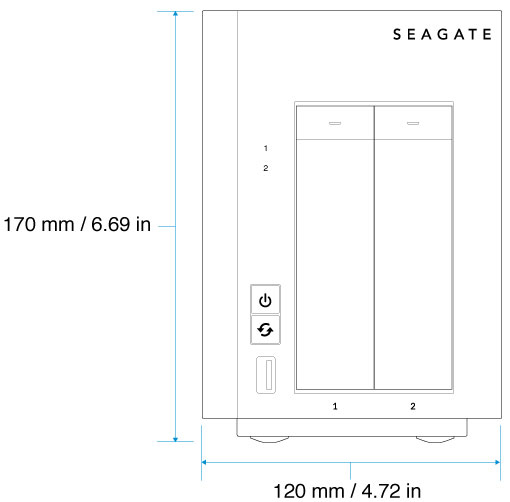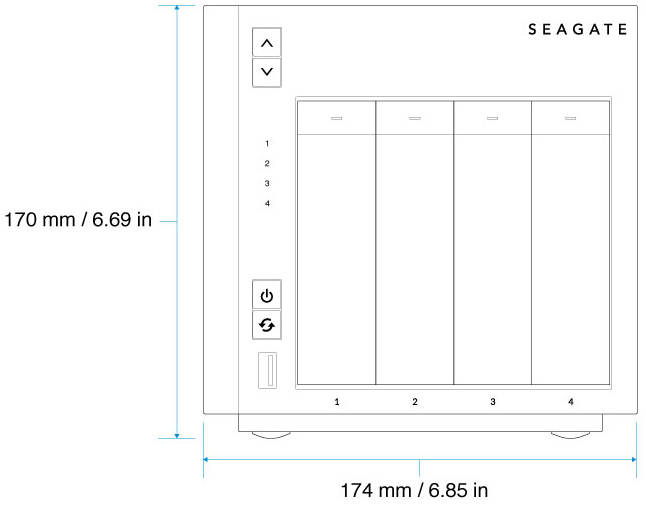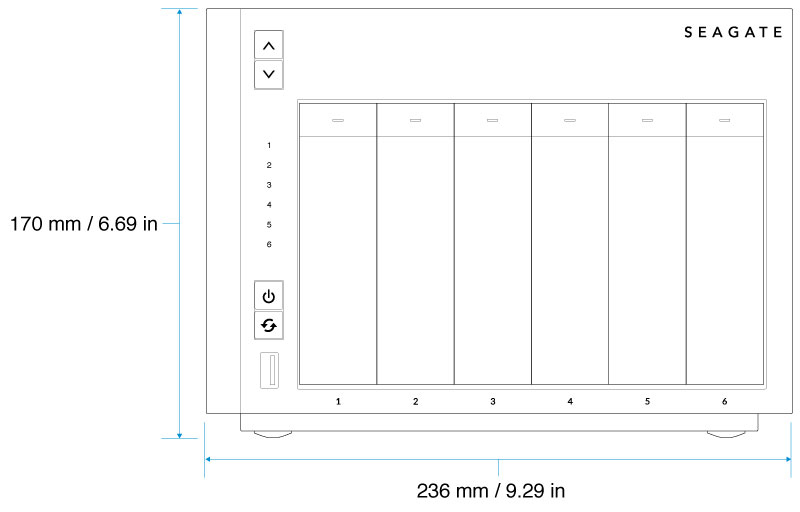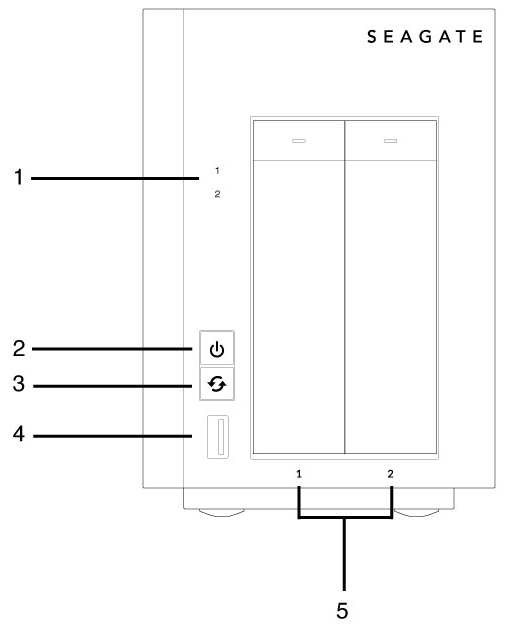Was this content helpful?
How could we make this article more helpful?
System Overview
The Seagate WSS NAS is a hard drive enclosure available in three models:
- Seagate WSS NAS 2-Bay (up to two 3.5 inch/2.5 inch hard drives)
- Seagate WSS NAS 4-Bay (up to four 3.5 inch/2.5 inch hard drives)
- Seagate WSS NAS 6-Bay (up to six 3.5 inch/2.5 inch hard drives)
Each individual hard drive is swappable and field replaceable. When installing hard drives into the Seagate WSS NAS, Seagate recommends 3.0 Gb/s SATA hard drives up to 7200 RPM. For optimal performance, use Seagate NAS HDD.
Specifications
Storage management
The Seagate WSS NAS is powered by Windows Storage Server 2012 R2 Essentials. Use the Windows Storage Server 2012 R2 Essentials dashboard to manage your Seagate NAS. You can create volumes, configure data protection, add users and much more.
Enclosure dimensions
WSS NAS 2-Bay


WSS NAS 4-Bay


WSS NAS 6-Bay


Enclosure weight
WSS NAS 2-Bay
| Disks | Disk capacity | Weight (Kg / lbs) |
|---|---|---|
| 0 | N/A | 1.75 / 3.86 |
| 2 | 2TB | 2.81 / 6.19 |
| 2 | 4TB | 2.82 / 6.22 |
| 2 | 5TB | 2.83 / 6.24 |
WSS NAS 4-Bay
| Disks | Disk capacity | Weight (Kg / lbs) |
|---|---|---|
| 0 | N/A | 2.45 / 5.40 |
| 2 | 2TB | 3.51 / 7.74 |
| 2 | 4TB | 3.52 / 7.76 |
| 2 | 5TB | 3.53 / 7.78 |
| 4 | 2TB | 4.57 / 10.08 |
| 4 | 4TB | 4.59 / 10.12 |
| 4 | 5TB | 4.61 / 10.16 |
WSS NAS 6-Bay
| Disks | Disk capacity | Weight (Kg / lbs) |
|---|---|---|
| 0 | N/A | 3.0 / 6.60 |
| 2 | 2TB | 4.06 / 8.95 |
| 2 | 4TB | 4.07 / 8.97 |
| 2 | 5TB | 4.08 / 8.99 |
| 4 | 2TB | 5.12 / 11.29 |
| 4 | 4TB | 5.14 / 11.33 |
| 4 | 5TB | 5.16 / 11.38 |
| 6 | 2TB | 6.18 / 13.62 |
| 6 | 4TB | 6.21 / 13.69 |
| 6 | 5TB | 6.24 / 13.76 |
Temperature ranges
| Ambient environment | Temperature range |
|---|---|
| Standard (operating) | +0ºC to +40ºC |
| Storage (non-operating) | -20ºC to +60ºC |
Humidity
| Environment | Humidity range |
|---|---|
| Standard (operating) | 0% to 90% non-condensing |
| Storage (non-operating) | 0% to 95% non-condensing |
Electrical
The included power supply is meant for use with the Seagate WSS NAS. It is not compatible with power supplies provided with other hard drive enclosures produced by Seagate, an affiliate of Seagate or a third party.
WSS NAS 2-Bay
External power supply: 100 - 240 VAC, 50 / 60 Hz, 12 V / 48 W
WSS NAS 4-Bay
External power supply: 100 - 240 VAC, 50 / 60 Hz, 19 V / 120 W
WSS NAS 6-Bay
External power supply: 100 - 240 VAC, 50 / 60 Hz, 19 V / 150 W
Acoustics
WSS NAS 2-Bay
Operational: 20-32 dBA @ 1m
WSS NAS 4-Bay
Operational: 22-32 dBA @ 1
WSS NAS 6-Bay
Operational: 24-32 dBA @ 1
Front panel view
WSS NAS 2-Bay

- Hard drive LEDS: The LEDs blink to indicate activity for the drive.
- Power button and status LED: Turn the NAS on/off (see Operation).
- Function button: Push the button to initiate the installation of the operating system (diskless models) and the recovery.
- SuperSpeed USB 3.0 Port: Connect a compatible USB storage device to the port.
- Hard drive bays: Bays for the hard drives.
For details on LED behavior, see System LEDs.
WSS NAS 4-Bay

- LCD up/down buttons: Push the up/down buttons to navigate the LCD menu.
- LCD menu: Review the WSS NAS’s settings (see LCD Menu (NAS Pro 4-Bay and 6-Bay).
- Hard drive LEDs: Activity LEDs for the hard drives.
- Power button and status LED: Turn the NAS on/off (see Operation).
- Function button: Push the button to initiate the installation of the operating system (diskless models) and the recovery.
- SuperSpeed USB 3.0 Port: Connect a compatible USB storage device to the port.
- Hard drive bays: Bays for the hard drives.
For details on LED behavior, see System LEDs.
WSS NAS 6-Bay

- LCD up/down buttons: Push the up/down buttons to navigate the LCD menu.
- LCD menu: Review the WSS NAS’s settings (see LCD Menu (NAS Pro 4-Bay and 6-Bay)).
- Hard drive LEDs: Activity LEDs for the hard drives.
- Power button and status LED: Turn the NAS on/off (see Operation).
- Function button: Push the button to initiate the installation of the operating system (diskless models) and the recovery.
- SuperSpeed USB 3.0 Port: Connect a compatible USB storage device to the port.
- Hard drive bays: Bays for the hard drives.
For details on LED behavior, see System LEDs.
Rear panel view
WSS NAS 2-Bay
- Recovery button: The recovery button, when pushed at the same time as the power button, is used to perform a Windows Storage Server 2012 R2 Essentials recovery. Use a pointed instrument to gently push the button within the cavity. See Seagate WSS NAS Recovery.
- SuperSpeed USB 3.0 port: Connect a compatible USB storage device to the port.
- Hi-Speed USB 2.0 port: Connect a compatible USB storage device to the port.
- Gigabit Ethernet ports (x2): Connect the Ethernet cable from the device to your network. See Setup.
- Power input: Plug in the AC adapter supplied with the NAS. See Setup.
- Ventilation: Keeps your NAS's power supply unit cool during operation. Be sure not to block the fan exhaust when using the product.
- Kensington lock: Secure the NAS to a desk using a compatible cable.
WSS NAS 4-Bay
- Recovery button: The recovery button, when pushed at the same time as the power button, is used to perform a Windows Storage Server 2012 R2 Essentials recovery. Use a pointed instrument to gently push the button within the cavity. See Seagate WSS NAS Recovery.
- SuperSpeed USB 3.0 port: Connect a compatible USB storage device to the port.
- Hi-Speed USB 2.0 port: Connect a compatible USB storage device to the port.
- Gigabit Ethernet ports (x2): Connect the Ethernet cable from the device to your network. See Setup.
- Power input: Plug in the AC adapter supplied with the NAS. See Setup.
- Ventilation: Keeps your NAS's power supply unit cool during operation. Be sure not to block the fan exhaust when using the product.
- Kensington lock: Secure the NAS to a desk using a compatible cable.
WSS NAS 6-Bay
- Recovery button: The recovery button, when pushed at the same time as the power button, is used to perform a Windows Storage Server 2012 R2 Essentials recovery. Use a pointed instrument to gently push the button within the cavity. See Seagate WSS NAS Recovery.
- SuperSpeed USB 3.0 port: Connect a compatible USB storage device to the port.
- Hi-Speed USB 2.0 port: Connect a compatible USB storage device to the port.
- Gigabit Ethernet ports (x2): Connect the Ethernet cable from the device to your network. See Setup.
- Power input: Plug in the AC adapter supplied with the NAS. See Setup.
- Ventilation: Keeps your NAS's power supply unit cool during operation. Be sure not to block the fan exhaust when using the product.
- Kensington lock: Secure the NAS to a desk using a compatible cable.
USB ports
The Seagate WSS NAS has:
- Two USB 3.0 ports (front and rear)
- One USB 2.0 port (rear)
Connect USB direct-attached storage (DAS) devices to the Seagate WSS NAS for backups. Compatible file formats for DAS include: NTFS, exFAT and FAT32. Other storage formats are not recognized by the WSS NAS. Capacity limitations do not apply.